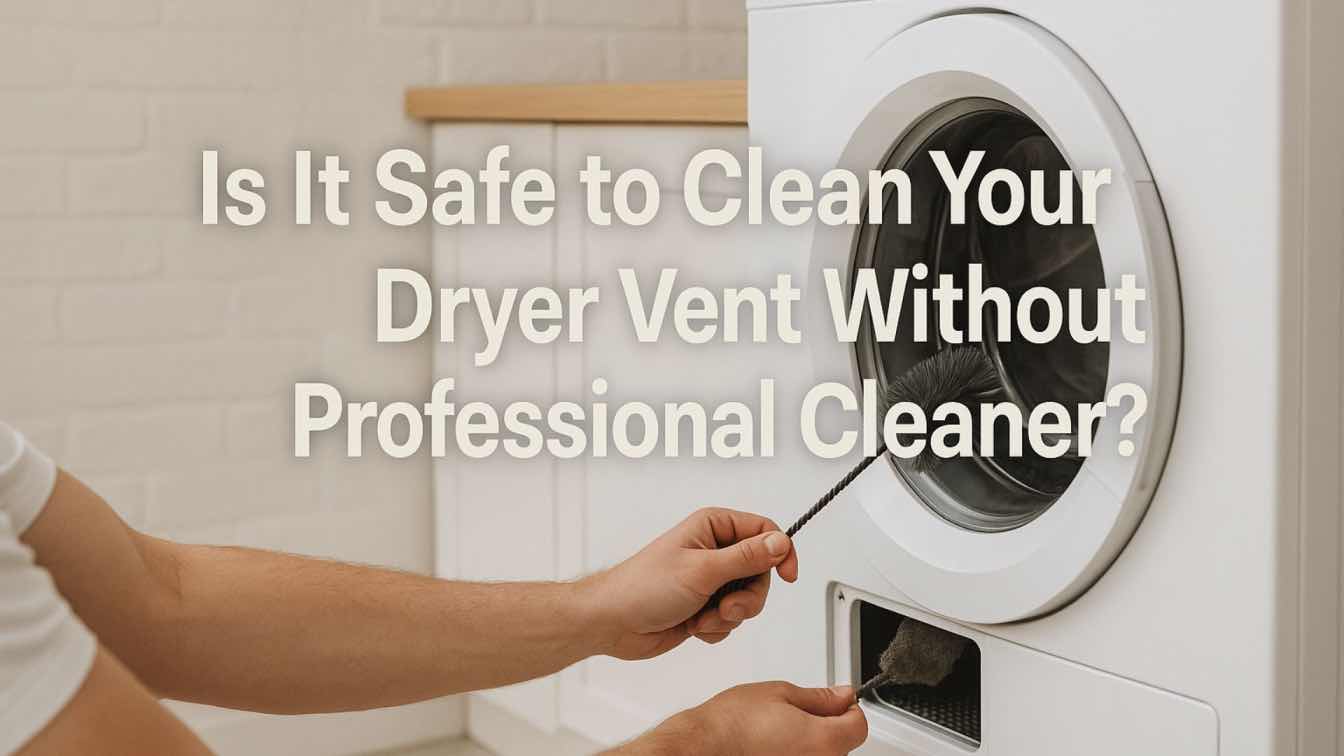Taking care of your home is important to keep everything safe and working well. One important job is to clean your dryer vent often. Over time, lint and dust can block the vent. This makes your dryer work harder and can even cause a fire.
But can you clean it yourself, or should you call a dryer vent cleaner to help?
Here, we’ll talk about the good and bad sides of doing it yourself, how to do it safely, and when it’s better to get help from a professional.
Why Clean Your Dryer Vent?
Dryer vents serve an important purpose: they channel hot, moist air and lint from your dryer to the outside of your home. When the vent is clogged, airflow is restricted, which can cause:
1. Longer drying times and increased energy bills.
2. Overheating of the dryer potentially damages internal components.
3. Increased risk of dryer fires due to lint buildup.
According to the U.S. Fire Administration, failure to clean dryer vents is one of the leading causes of home fires related to laundry appliances. Therefore, cleaning your dryer vent regularly is vital for safety and performance. However, if you want the best Dryer Vent Cleaning Cumming, contact MMI Home Improvement Pro.
Can You Clean Your Dryer Vent Yourself?
Many homeowners wonder if they can safely handle this task themselves. The answer is yes, but with important caveats.
When It’s Safe to Clean Your Dryer Vent on Your Own
1. You have basic DIY skills.
2. The vent is accessible and relatively short (e.g., a straight duct).
3. You have the proper tools, such as a dryer vent cleaning brush or vacuum attachment.
4. You understand how to disconnect and reconnect the dryer safely.
For many homes, these conditions are met, and cleaning your dryer vent yourself can save money and be fairly straightforward.
Tools You’ll Need to Clean Your Dryer Vent
To clean your dryer vent properly without professional help, make sure you have:
1. A screwdriver or nut driver (to disconnect the vent).
2. A dryer vent cleaning brush kit (flexible rods with a brush head).
3. A vacuum cleaner with a hose attachment.
4. A flashlight to inspect inside the vent.
5. A mask and gloves to protect yourself from dust and lint.
Step-by-Step Guide to Clean Your Dryer Vent Yourself
1. Unplug the dryer and move it from the wall to access the vent.
2. Disconnect the vent duct from the dryer exhaust.
3. Use the brush tool to scrub inside the vent duct, pushing lint towards the opening.
4. Vacuum out the loose lint from the vent and ductwork.
5. Inspect the vent outlet outside your home for blockages or damage.
6. Reconnect the vent duct securely to the dryer.
7. Push the dryer back into place, plug it in, and test the dryer.
Risks of Cleaning Your Dryer Vent Without a Professional
While DIY cleaning is possible, there are risks and limitations:
1. Incomplete Cleaning
Professional cleaners use specialized equipment like rotary brushes and powerful vacuums to remove deep-seated lint that standard brushes might miss. DIY tools may not reach bends or long duct runs fully, leaving behind dangerous lint buildup.
2. Potential Damage
Improper handling can damage the dryer vent duct, tear or crush flexible ducts, or disconnect the vent improperly, causing leaks of hot air and lint into your home.
3. Safety Hazards
Disconnecting and moving your dryer can expose electrical connections or gas lines (in gas dryers). Without proper knowledge, this can pose risks of electric shock or gas leaks.
When to Call a Professional Dryer Vent Cleaner
You should consider professional cleaning in these cases:
1. Your vent duct is long, has many bends, or runs through walls or ceilings.
2. You notice your dryer takes longer than usual to dry clothes.
3. You smell burning or see visible signs of lint buildup near the vent.
4. Your dryer overheats or shuts off unexpectedly.
5. You’re unsure how to safely disconnect or clean your dryer vent.
Professional cleaners have the experience, tools, and knowledge to clean your vent thoroughly and safely. They can also inspect for damage, improve airflow, and help prevent fire hazards.
How Often Should You Clean Your Dryer Vent?
Experts recommend cleaning your dryer vent at least once a year. However, if you:
1. Use your dryer heavily (e.g., large families or frequent laundry loads).
2. Have pets that shed hair.
3. Notice longer drying times or overheating.
You may need to clean your vent more often, even twice a year. Regular inspections can help catch lint buildup early.
Benefits of Professional Dryer Vent Cleaning
While cleaning your dryer vent yourself may work in some cases, hiring a professional has several advantages:
Thorough cleaning: Professionals can remove lint deep inside the ducts and dryer components.
Safety inspection: They check for damaged or improper vent installation.
Time-saving: Professionals clean vents quickly, with minimal disruption.
Fire prevention: Proper cleaning reduces fire risk significantly.
Energy efficiency: A clean vent means your dryer runs faster and uses less electricity.
Tips for Maintaining Your Dryer Vent Between Cleanings
Even if you decide to hire a professional, you can maintain your dryer vent daily:
1. Always clean the lint filter after every load.
2. Avoid overloading your dryer.
3. Use the correct type of vent duct (rigid metal ducts are safer than plastic or foil).
4. Keep the area around the dryer clean and free of clutter.
Summary
Cleaning your dryer vent without a professional can be safe if you have the right tools, knowledge, and a straightforward vent setup. However, there are risks of incomplete cleaning and damage if you don’t know what you’re doing. For complex vent systems or if you detect any warning signs like longer drying times or overheating, hiring a professional dryer vent cleaner is the safest choice.
Prioritize safety and efficiency by inspecting your dryer vent regularly and cleaning it at least once a year. Whether you do it yourself or call an expert, a clean dryer vent helps prevent fires, reduces energy costs, and extends the life of your appliance. If you want peace of mind and expert service, consider scheduling a professional dryer vent cleaning today. Your home’s safety depends on it!





